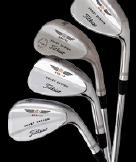GOLF EQUIPMENT  The Titleist Vokey
|
|
Vokey clearly knows what he's doing...And he's humble to boot. |
I tried the Vokey wedge in three ways--full swing shots; short chips and pitches; and, of course, bunker play.
For full swing shots, I found the Vokey wedge to have a very soft feel and be fairly easy to hit--at least more so than my old 56 degree. I've had a tendency in the past to hit sand wedges thin or fat. The Titleist wedge improved on that. And true to Vokey's words, the wedge performed best in soft sand, rough and softer fairway conditions.
On harder lies, I still had the same tendency to hit the ball thin with the Vokey as with my other wedge--but to a lesser degree. But for full swing shots from rough or soft fairway, I'd rate the Vokey's performance as exceptional, and with a noticeable difference from my other equipment. I could still get the same 90 yards with it that I get from my old 56, but with a softer feel and better spin on the ball. The ball even spun backwards on a couple occasions, and I'd never been able to get that result in the past.
For Chips and Pitches, much is the same as with full swing shots. The Vokey was exceptional out of rough and mushy stuff--even tall grass. For hard pan lies, I had less success, but still better than before.
|
Sand performance was outstanding. I'd never rate my bunker performance as anything better than below average, but the Vokey's making the thought of being in sand much less intimidating. The club glides nicely through the sand to get just enough ball to clear the lip and land softly on the green--and stay where it's supposed to.
Bunker play was never this easy. In the past, I had a tendency to leave the ball in the sand or hit too thin and sky the target. A big performance jump with the Vokey here-and much less business for my sports psychologist when it comes to sand play. This in itself is worth the price of the club.
In other words, my results with the Vokey wedge were not only positive, they were just as Bob Vokey predicted. He's got the fitting down to a science, even
if his humility won't allow him to admit it.
"For your higher handicapper, you'll probably go with a little more bounce, a little bit wider flange to keep him from 'digging in'-because he's probably got a steeper swing. For your better player, he's a 'slider,' a shallow cut player, he likes to take it back and moves his arms and shoulders through the ball. He takes a firm and hard enough swing so that he splices just enough sand and pops the ball out-he doesn't need as much bounce."
 "Every individual is different though, and this isn't a science. There're techniques involved too. Every club maker has his own techniques. At Titleist, we try to provide variety-enough of a variety of lofts, bounce and sole conditions-because loft's another determining factor. For some courses-if you've got pot bunkers, you're going to need a little bit more loft."
"Every individual is different though, and this isn't a science. There're techniques involved too. Every club maker has his own techniques. At Titleist, we try to provide variety-enough of a variety of lofts, bounce and sole conditions-because loft's another determining factor. For some courses-if you've got pot bunkers, you're going to need a little bit more loft."
Vokey clearly knows what he's doing. He's had the practice, the feedback, and the experience to get it right. And he's humble to boot. I'll definitely continue to use my 258.12 model, and look to Bob to provide advice on what other utility wedges might be helpful for my game.
He left me with one thought: "The perfect wedge doesn't exist. It's just not fair."
Well, with the accumulated scholarly learnings of the devoted sand wedge pupil, Bob Vokey's as close as they come to a real genius.
Titleist Vokey Design Wedges
200 Series; 300 Series; 400 Series. Varied Lofts and Bounces to suit playing conditions and styles of play.
Suggested Retail: $115 for Chrome; $125 for Raw Finish
Available at Fine Pro Shops and Golf Retail Stores
Website: http://www.titleist.com/htm/clubs/vokey_200.asp